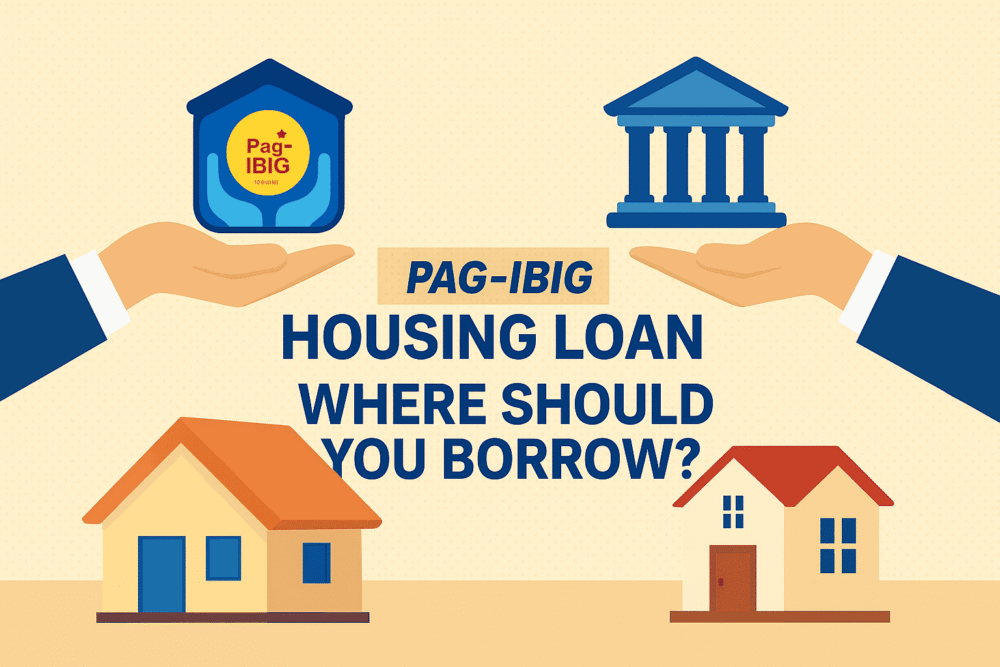When it comes to buying your dream house, most Filipinos face the same question: Should I get a housing loan from Pag-IBIG or from a bank? Both options have their advantages and disadvantages, and the right choice really depends on your situation, income level, and future plans.
In this article, let’s break down the differences between Pag-IBIG Housing Loan and Bank Housing Loan, so you can decide which one fits you better.
Pag-IBIG Housing Loan: Pros and Cons
Pros
- Lower interest rates for minimum wage earners – Pag-IBIG offers subsidized interest rates as low as 3%–6.5% for minimum-wage earners, which is hard to beat.
- Longer repayment terms – You can pay up to 30 years, making the monthly amortization lighter.
- Easier approval for low to mid-income earners – Pag-IBIG is more lenient compared to banks, as long as you have a stable income and active contributions.
- Special programs – Pag-IBIG sometimes offers calamity assistance or restructuring for members struggling with payments.
Cons
- Longer processing time – Approval can take weeks or even months, unlike banks that usually respond faster.
- Loan amount limit – Maximum loanable amount is ₱6 million, which may not be enough if you’re buying a more expensive property.
- Strict property accreditation – The house or condo you want to buy must be accredited by Pag-IBIG.
Bank Housing Loan: Pros and Cons
Pros
- Higher loan amounts – Banks can finance properties well beyond ₱6 million, perfect for those buying in prime locations.
- Faster processing – Some banks can approve within a week if your requirements are complete.
- Flexible loan options – Banks often give you choices on fixing interest rates for 1, 3, 5, or even 10 years.
- More property choices – No need for accreditation as long as the property has clean documents.
Cons
- Stricter requirements – Banks will scrutinize your income, credit history, and employment background.
- Shorter loan terms – Most banks allow up to 20 years only, which means higher monthly payments.
- Interest rate fluctuations – If you don’t lock in a fixed rate, your monthly amortization can rise with market changes.
Side-by-Side Comparison
| Feature | Pag-IBIG Housing Loan | Bank Housing Loan |
|---|---|---|
| Loan Amount | Up to ₱6 million | Depends on bank, can exceed ₱20M+ |
| Interest Rate | 3%–7% (depending on income bracket) | 6%–10% (depending on fixing period) |
| Repayment Term | Up to 30 years | Up to 20 years |
| Processing Time | Weeks to months | A few days to weeks |
| Approval | Easier for average earners | Stricter, based on creditworthiness |
| Property Restriction | Must be Pag-IBIG accredited | Wider property options |
So, Which One Should You Choose?
- Choose Pag-IBIG Housing Loan if:
- You’re a minimum or average income earner.
- You want lower monthly amortization and longer terms.
- You’re okay with slower processing and a capped loan amount.
- Choose Bank Housing Loan if:
- You have a higher income and good credit standing.
- You’re buying a property above ₱6 million.
- You want faster approval and more property choices.
Blogger’s Corner
Personally, I think Pag-IBIG Housing Loan is the better option for most working Filipinos because of the lower interest rates and longer repayment period. However, if you have the capacity and need to borrow a bigger amount, banks give you the flexibility that Pag-IBIG can’t match.
At the end of the day, it all boils down to what you can comfortably pay every month. Owning a house is a huge commitment, so make sure your loan choice won’t leave you financially drained.
If you want a step-by-step guide on how to apply housing loan through Pag-IBIG, check out my detailed post here: Pag-IBIG Housing Loan Guide.
